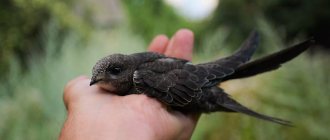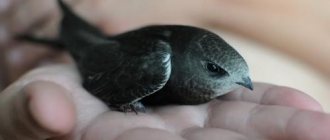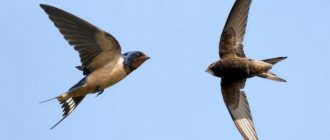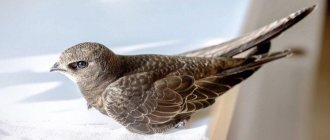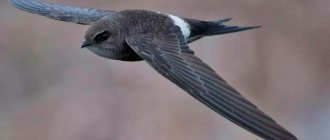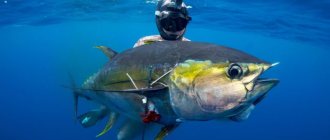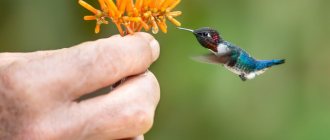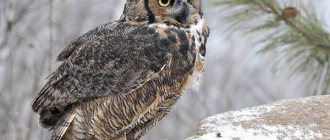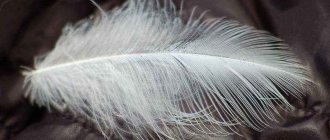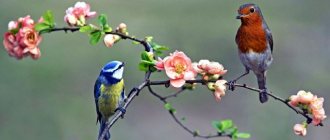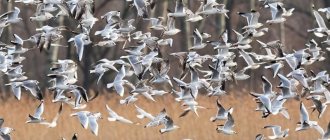These are small birds, strikingly similar to swallows. In fact, these two bird species are not related at all. Swallows are closer to sparrows, and the swift's closest relative is hummingbird. But their similarities are so great that these birds are often considered two species of the same genus. Curiously, swifts are considered recognized record holders for flight speed. Representatives of the needle-tailed family can accelerate to 170 km/h. Probably the high-speed train “Strizh”, running on the route Moscow - Nizhny Novgorod, was named after them. There are other interesting facts about the swift.
These birds are the real kings of the air. Some individuals may not land for years, spending all their time flying. They can even sleep on the fly. This feature greatly helps them during long flights. It is noteworthy that there is not a single aircraft whose aerodynamics surpasses swift flight. Therefore, from an engineering point of view, these birds are technical perfection. We have collected for you the most amazing and unusual facts about swifts.
How to recognize a swift?
What does the bird look like? The characteristics of its appearance are as follows: middle-aged birds have a darkish-brown color, their neck is whitish, their beak is black, their rump and legs are dark brown. The description can be supplemented by the fact that juveniles are much lighter and have white spots on top of the feathers than young ones.
The bird loves to wander and makes long flights, traveling to the breeding area quite late (for example, in the southern regions of Russia - in April, and in the northern part - in May) and leaving the nests very early. The arrival of a black swift is easy to notice by its strong scream (as if there is a loud screeching around).
Black swifts return late, not like other birds. This is the herald of the full arrival of spring, however, even after its return, cold days sometimes come. Late frost can destroy these delicate creatures.
Difference from swallows
Swifts and swallows are very similar in color and size, so they are often confused. However, upon closer examination, it becomes clear that these are completely different birds. They even belong to different groups.
In size, swifts and swallows are quite comparable: the same wingspan, the same body length, but the weight of a young swift is twice that of a swallow. They also differ in color. Despite the fact that the plumage of both is dark, the swifts have a greenish tint and have a small white spot on the chin and throat. A distinctive feature of the swift is also its sharp beak, with which it seems to cut the sky (hence the name).
Swallows have ordinary bird feet with three toes pointing forward and one toe pointing back. Thanks to this structure of the paws, the birds can easily stay on the perch and move along the ground.
Swifts have unique feet. All four fingers point forward, making it very difficult for birds to maintain balance. This feature determines the way swifts sleep: they hang upside down on a branch, since they cannot stand. In addition, forward-pointing fingers make it difficult to take off from a support, but once the birds take to the sky, they forget how stupid they look on the ground. In flight, swifts reach speeds of up to 170 km/h, while swallows only reach speeds of 60 km/h.
Another difference is that after wintering, swifts are the last to arrive, while swallows are the harbingers of spring.
Bird habitat
The swift lives in the main part of the Palearctic region. It can be found in the western part of Europe and up to 70ᵒ northern latitude. The birds nest in most of the Asian territory, with the exception of southern China and India. The swift usually winters in Africa.
Swift is a bird with an outstanding ability to fly.
Being originally inhabitants of rocky terrain, the birds eventually adapted to human settlements, and the swift became a full-fledged inhabitant of a city or village. Birds primarily preferred high-rise buildings and ancient buildings, especially towers, for nesting. Where there are rocks suitable for the black swift, it still settles today. In mountainous areas it can rise up to about 2 km.
Birds fly to central Russia before the onset of summer, when clear days have established and other birds have already built nests, laid eggs or are feeding their offspring. Having arrived in their native places, the birds begin building nests. If they cannot find a suitable place, violent fights with other birds begin. They can even outlive starlings or sparrows from their homes.
2.But they are not their relatives. This is a fundamentally different genus of birds from swallows. Swallows belong to the passerine family, and swifts belong to the order Swifts.
3. Swifts can be easily distinguished from swallows by their narrower wings, less maneuverable flight and, of course, speed.
4. Over 85 species of this order have been identified throughout the world. Some types of swifts are considered champions among birds in terms of flight speed. (The needletail reaches speeds of up to 170 kilometers, while the fastest swallow makes no more than 70 kilometers per hour).
5. The swift is a bird that can be found in almost all corners of the planet. You won't find them except in Antarctica, southern Chile and Argentina, New Zealand and most of Australia.
6. Swifts have a large head, body size is 10-25 centimeters, weight, depending on the variety, from 45 to 180 grams. They have a sharp beak, but rather short. Eyes are dark in color. The swift's wings are curved and oblong, the tail is forked, long and straight.
7. The plumage of the swift is dark in color - black and gray shades with gloss. However, swifts with a belt of white feathers are also often found. White feathers may also be present on the bird's chest, under-tail area, on the inside of the neck and on the forehead. It is impossible to determine the sex of a swift even upon close examination. There are no differences in the appearance of females and males.
BLACK SWIFT
8. The most widespread and famous in Europe, Asia, and Africa is the black swift. Black swifts live mainly in cities. Black swifts build nests from blades of grass, feathers, and leaves, which they collect in the air on the fly.
9. The clutch of a black swift contains 2-4 white eggs. Only females incubate her for 18 days. The hens are fed by males, who usually keep in a flock: they fly away together to get food for the females, return together with prey (they take a mouthful of food, cover it with saliva, and then carry this lump to the children).
10. Black swifts often nest in large colonies, with each pair returning to their nest year after year. The young leave the colonies and usually begin their first nesting in a completely different place.
11. In bad weather, the chicks fall into torpor, their body temperature drops to 20° (almost twice as much as normal!), and in this state they can remain without food for up to 10-12 days. At this time, adult swifts migrate tens of kilometers to the south, leaving children without food.
WHITE-BELLIED SWIFT
12. In our country there are also white-bellied and small (in Central Asia) and needle-tailed (in the Far East and Siberia).
13. Swifts are “children of the air.” Other birds can fly and swim, walk and run on the ground. Swifts can only fly; they cannot walk or swim. While in flight, swifts drink and swim.
14.In the guise of swifts, the idea of flight, which gave birth to the entire world of birds, was realized with purely academic completeness. Theoretical calculations convincingly indicate that with the appearance of swifts, the long history of the evolution of living aircraft came to an end. It is impossible to fly better than a swift.
15. Swifts also have one more feature - sharp and significant fluctuations in body temperature. Of course, swifts are warm-blooded animals, there is no doubt about that. But their body temperature, to a greater extent than that of other birds, depends on the ambient temperature. Moreover, if the temperature drops too low, the swifts hide in the nest and seem to go into hibernation, torpor.
16. Swifts' legs are small, weak, with sharp claws. These birds practically cannot walk on the ground; they can only perch on branches or cling to vertical surfaces with their claws.
17. A swift cannot take off from the ground - its wings hit the ground when flapping. (The exception is black swifts - they can jump and take off.) Others, in order to rise into the air, need some kind of springboard, some kind of elevation. Therefore, swifts do everything they need in the air: they catch insects, look for building materials and bedding (fluff, dry blades of grass raised by the wind, and so on).
WHITE-BELT SWIFT
18. In the east of our country and in some other countries, the bulk of the “urban” ones are white-banded swifts. They are similar both in appearance and in their lifestyle.
19. Both of them, having arrived, immediately begin to build nests. They take a week to build, a little more. And as soon as the nest is ready, they lay eggs. There are usually two of them. Both parents incubate. Incubation lasts about eleven days, but maybe longer - it all depends on the weather.
20. Moreover, it depends on the weather whether the swifts will incubate the eggs at all and whether the chicks will appear at all. After all, these birds are very dependent on the weather.
21. During bad weather, there are no insects in the air - the birds go hungry and may even die from starvation. To prevent this from happening, during prolonged bad weather, birds hibernate. Or sitting in a nest. But their body temperature at this time becomes so low that there is not enough heat necessary for incubation. And the swifts throw the eggs out of the nest. It’s as if they know that nothing will come of it.
22. But if everything goes well, the chicks will appear. And they will sit in the nest. But how much again depends on the weather. They can spend 33 days in the nest, or maybe 55.
PINK-TAILED SWIFT
23. Spiny-tailed swifts live in sparse, often swampy forests along river valleys, on plains and on mountain slopes, clearings and burnt areas with surviving individual trees. They nest in hollows, often very large: up to three to four meters deep and 35-50 centimeters in diameter.
24. Swifts have another amazing feature - they can sleep in the air! And not for a few minutes, but for several hours, gliding high in the sky, occasionally moving its wings in its sleep. In the morning they wake up and go about their usual business - they start catching insects.
25. The black swift catches insects with its beak right in flight. The structure of the jaw allows you to put up to 1000 insects into your mouth at a time.
AFRICAN PALM SWIFT
26. The African palm swift is widespread in the tropical zones of Asia and Africa. He builds a very original nest. However, calling this structure a nest can be a bit of a stretch.
27. It is rather a pad glued together from down and small feathers and attached to the underside of a palm leaf. The eggs will not lie on such a cushion, and the bird will not be able to sit, especially since the palm leaf hangs almost vertically.
28.That’s why the swift sticks the eggs. And he sits on them, clinging tightly to the pad with his claws. So he sits until the chicks appear. And they, as soon as they are born, cling to the pad with their claws and sit like that until they grow up.
29. There is another interesting pattern, this was noticed back in 1855 by K. F. Kessler: birds that arrive early almost always fly away late in the fall, and those that arrive late in the spring fly away early, among the first. For example, swifts arrive with the fourth echelon of birds, and are among the first to fly away - in August. By the way, this phenomenon was inexplicable for a long time: swifts catch insects in the air, just like swallows.
30. It turns out that it’s all about vision, or, more precisely, about the structure of the eyes: swallows can see insects flying around and chase them. Swifts do not chase insects - they almost do not see them. They fly with their mouths open and, like a net, capture those they come across on the way. There is a large percentage of randomness here. And if there are a lot of insects, this percentage is large enough to satiate both the adult birds and the chicks in the nest. And when there are few insects, the percentage decreases.
31. Swifts can live both in large and small cities, as well as in mountains, forests and deserts. The choice of nesting site for these birds can be varied. They can “build” housing on tree branches, in hollows, under the roofs of houses and in earthen holes.
32. And the Cayenne swift lives in America. It is also interesting with its nest. Having caught a sufficient amount of plant fluff in the air, the bird glues it together with saliva and makes a rather long tube from this material. Having hung it on a branch, the swift glues a pocket to one side of the tube, in its upper part. This is a nest chamber.
33.The nest itself is built from natural materials of plant origin available to these birds. When the time comes for construction, swifts are unable to collect leaves, sticks, or dirt from the ground, as is often the case with other birds.
34. Among the materials there will be all kinds of fibers, feathers, small branches that the bird can bring, picking up on the fly. It takes a couple about 7 days to build one dwelling, but every year after the winter hut they return back to their native abode.
35. Swifts, like swallows, are migratory birds, and in early August they leave their native places to spend the winter somewhere in South Africa or Madagascar.
Swift of the Salangan type
36. In Southeast Asia, on the islands of Indonesia and Polynesia, swiftlets live. These birds nest in colonies in caves, often in complete darkness. In caves, they use echolocation, that is, they make special sounds, and by their reflection from the walls they orient themselves in space. However, only those birds that live in caves are capable of echolocation. Those that nest openly do not possess these abilities.
37. All swiftlets (and there are about 20 species) make their nests from saliva, including pieces of plants, bark, and lichens. These nests are valued, but much less than the nests of the gray swiftlet - this swift's nest is clean, because the bird makes it exclusively from saliva. Cup-shaped nests glued to a vertical rock, usually in the depths of caves.
38. These are the same “swallow’s nests” from which Chinese chefs cook soup, highly valued by gourmets. They say that the soup is truly excellent, and the nest itself tastes like sturgeon caviar. However, many people don’t like this dish - it’s a matter of taste, of course.
39. Swifts do not have many natural enemies. This affects all species of swifts on the planet. The main dangerous enemy and adversary is the Hobby bird of prey.
40. It is very difficult for other birds of prey to catch a swift because it not only flies too fast, but practically does not touch the surface of the ground. Swifts may also be under threat during seasonal migration periods.
SWIFT CLEJO
41. Klekho - representatives of another family of the order - the family of Crested Swifts. They are indeed crested, but otherwise similar to all swifts. Except that sometimes, unlike them, they sit on trees.
42. Crested swifts also make nests in trees, and these are the smallest bird nests in the world (corresponding, of course, to the size of the bird). These swifts make nests on thin bare branches and lay one single egg in them. It simply won't fit anymore!
43. It is impossible to incubate in such a nest. Therefore, the female does not sit on the nest, but sits nearby and covers the egg with her belly feathers. The chick sits in the nest for some time, but soon it becomes crowded there and he moves to a branch. He sits on it until he grows up.
44. Swifts may leave their nest if there are fewer insects around. Basically, this situation occurs when rainfalls begin, and small beetles hide in the ground and bark of trees. A folk superstition is associated with this fact: if swifts fly high, the weather will be good; if low, expect rain. The explanation is simple - increased humidity in the air causes insects to descend closer to the ground. Accordingly, the birds are forced to descend after them.
45. After the first year of life, swifts begin puberty. But adults become parents only in the third year. After this, they actively reproduce for two years. The male finds a mate in the air and stays with her for life. Mating takes place in the sky, and then nesting begins.
46. The height of the place where the nest will be located should not be less than three meters. Therefore, a young couple chooses a steep cliff or a tall tree, mainly near a river. City swifts nest under balconies or roofs of tall buildings.
WHITE-BACKED SWIFT
47. The largest swift, the white-backed one, is 25 centimeters long and weighs 175 grams (about the weight of one lemon).
48. Swift chicks eat a lot. During their growth, an adult individual brings about 40 thousand insects each. To deliver so much food, he has to make 30-40 search flights. In total, the distance over which the swift flies during the search reaches 40 thousand kilometers.
49. 10 weeks after birth, swift chicks are able to feed and fly independently. They rise up to a height of 2000 meters and remain there until they grow up. Swifts sleep only in flight, waking up every 10 seconds to flap their wings.
50. There are rehabilitation centers for swifts all over the world. Chicks that have fallen from the nest often end up there, usually in rainy weather. People pick them up, but it is almost impossible to feed this bird at home.
photo from the Internet
Gallery: black swift bird (25 photos)
Character and lifestyle
The black swift is hardy and spends most of its time flying in the sky, where it eats, drinks, mates, bathes and even sleeps. The flight is fast and maneuverable. Movement in the air is economical. The flapping method followed by sliding changes to vibrations and free floating. Swifts gather in groups during the mating season and before migration.
With the exception of two months of nesting, the bird spends the rest of the year in flight.
Developed memory and echolocation allows them to nest in dark caves, in attics, and feed at dusk. To navigate in space, birds emit signals that correspond to the sound of the teeth of a comb along which an object is passed.
In the evening, representatives of the swift family descend to rest on tree trunks, walls, and fly into crevices and hollows. The group's sleep is restless and sensitive. You can hear tapping throughout the night.
Mating behavior has not been fully studied. Monogamous pairs are formed during the first migration and remain for many years. Every year the pair returns to the old nesting site simultaneously or with an interval of up to three weeks.
There is a lot of evidence of mating in the air. But scientists cast doubt on the observations, since cases of copulation in the nest have been recorded.
Offspring
The female usually lays 2 eggs, with rare exceptions there may be more. The eggs are elongated, whitish in color, length - 2.6 cm, width - 1.6 cm. The female incubates the eggs, and the male feeds her at this time.
Hatched chicks need food. Both parents take care of the offspring. During one visit of the parent, only one chick receives food.
Birds eat small and other insects. The male does not swallow the small ones one at a time, but collects them in his beak until they turn into a lump along with saliva. Only when the lump is ready does the swift swallow it or carry it to the swiftlets. Swifts are voracious, they kill a lot of insects, but most of them do not benefit humans.
Under the influence of external factors, when it becomes cool outside, the chicks’ body temperature may drop: 2-3ᵒ C above atmospheric. This state of absolute hunger can last 5-10 days. During this period, the shearer's body feeds on accumulated fat deposits.
Reproduction
These birds nest in trees, hollows, rock crevices, burrows and caves. It all depends on the habitat. Birds live in forests, cities, mountains and deserts. Pairs are created for life.
The swift's nest is built from plant fibers, twigs and feathers, which the birds pick up on the fly. Every year the birds return to their former nests. Construction of the home lasts about a week.
The eggs are incubated by females for 16-22 days, during which time the male flies off in search of food. The clutch usually contains white eggs, there may be four or only one.
The chicks do not leave the swift's nest for 33-39 days, depending on weather conditions. Their parents feed them several times a day with compressed lumps of saliva and insects. Then the chicks fly away, because they are completely ready to live an independent life.
Natural enemies
Due to their high flight speed, vertical nesting and dark, uniform plumage, black swifts have few enemies. Young and sick birds are caught by buzzards, hawks, and hobby falcons. When defending territorial borders, fights with sparrows, swallows, starlings and even rock pigeons occur.
The struggle lasts for hours and often ends tragically. During a fight, the swift raises its wings, revealing strong legs with sharp claws. Sometimes a numerical advantage is used. The pair clamps down on the enemy, striking from both sides.
Population and species status
It is difficult to accurately track the bird population due to the secrecy of nests and the presence of immature individuals in the colony.
Despite this, the vast distribution area maintains numbers and makes it possible to change a nesting site that has become unsuitable as a result of human activity or climatic conditions.
Due to its abundance, the species is not considered vulnerable, has no protected status, and causes the least concern.
